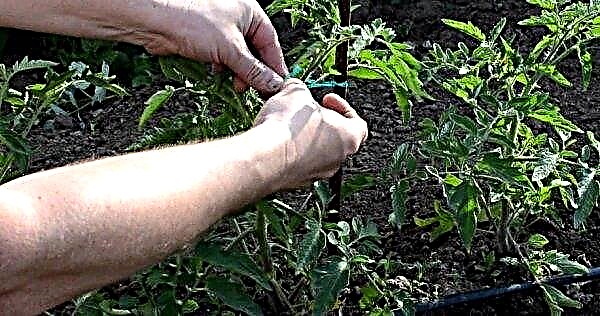Landscape design is the art of decorating various territories and objects with the help of non-natural and natural materials, plants, reservoirs, etc. One of the inexpensive elements of decor is pebbles. It is about its diversity and ways of using it in different stylistic decisions that will be discussed later in the article.
Types of pebbles for design
To begin with, it is worthwhile to become more familiar with the definition of pebbles and its varieties. This is a natural stone, with a rounded surface, bulges and depressions. Usually considered natural material is flattened, round or oval. In terms of dimensions, the stones are small - from 2 to 10 cm in length. The color of natural specimens can be gray, white, brown, black, etc.
Natural pebbles are formed under the influence of water and wind. Artificial imitation is created by machining - hard rocks (marble, granite, etc.) are crushed, then polished, ground and painted in the desired color.Important! Do not confuse pebbles and rubble. The second is also a stone, but it is obtained as a result of crushing rocks, therefore it has sharp edges and chips, and is used in construction.
 There are several types of pebbles. They are different among themselves in size, color palette, place of production, etc. characteristics that determine their scope.
There are several types of pebbles. They are different among themselves in size, color palette, place of production, etc. characteristics that determine their scope.
Types of pebbles:
- Marble - formed from residues after the formation of whole pieces of rock. Designed for landscape design.

- White - mined near mountain ponds. Suitable for laying garden paths, fountains, artificial lakes or streams, as well as shop windows.
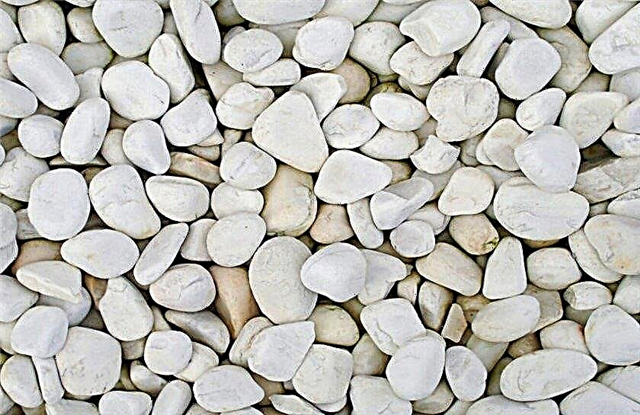
- Gray - small stones with a glossy surface. Mostly used for wall decoration of functional objects (baths, saunas, bathrooms).
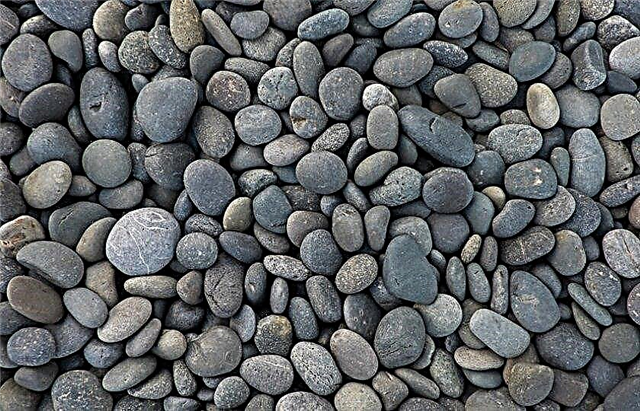
- Black - made of marble and dolomite, amenable to polishing and possibly coated with a glossy composition. It is highly resistant to temperature extremes and the effects of other external factors, universal in application.

- Marine - mined on the coasts of salt reservoirs. Suitable for decorating various decorative elements in household territories, zoning walls, laying out the floor pattern.

- River - a natural material formed by water and wind from quartz and granite. It can have black, gray, white or three-color color, it is universal in application.

- Caspian - mined on the coast of the Caspian Sea. It is created under the influence of natural factors from sedimentary rocks. Widely used in landscape design, as a decorative element.

- Black Sea - predominantly painted in gray, rounded. The source is the coastline of the Black Sea. The use in the landscape is quite wide.

- Granite - produced from granite residues. It has a very high strength and resistance to various environmental factors. It is applied to external and internal works.
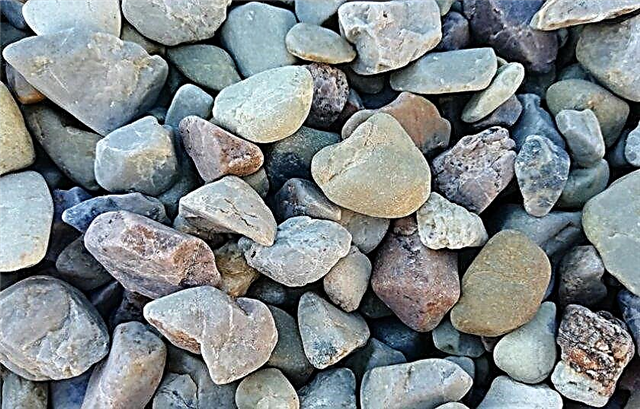
- Silicon - created on the basis of flint. It is mainly used for laying walls and bottom in artificial reservoirs, because the breed has disinfecting properties and sorb chemical compounds well.

- Glass - From the name it is clear that glass is used to produce this pebble. After special treatment, the stones are painted in the desired color. Used for the design of bathtubs, bathrooms, mirrors, as well as the creation of various decorative elements to decorate the landscape.

- Washed - get this type after special treatment, involving the removal of impurities. This pebble is very convenient to use and lends itself well to bonding.

- Color - Another artificial variety, painted with a special composition, which provides it with strength and protection against burnout. Great for outdoor use.

- Decorative - from gypsum, slate, granite and marble waste. The material can be given any shape, size and color. Designed for interior and exterior decoration.
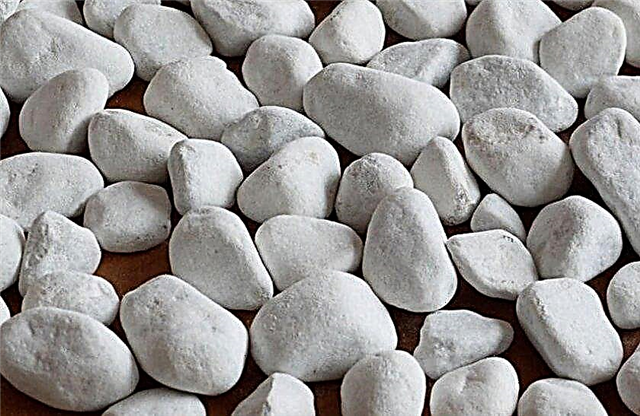
The use of pebbles in landscaping
Pebbles are considered a universal material. It is perfect for:
- wall cladding of architectural structures and buildings;
- registration of reservoirs and alpine hills;
- laying of flooring;
- create different shapes and statues.
Its main advantages are low cost and ease of operation. And the elements made with her participation differ not only in attractive appearance, but also in durability.
Garden paths
When arranging tracks on a site, the first thing you should do is display your idea on paper. When making a drawing, it is important to consider the length, width, shape of the object. You should also think about the pattern and color scheme in advance. Based on this, it will be possible to more accurately determine the amount of material. When the calculations are made and the drawing is created, it is worth taking care of where to get the raw materials. You can buy it in a store or, if there are ponds nearby, assemble it yourself. When choosing the second option, if there are not enough stones of a certain color, they can always be tinted with an acrylic coating.
Important! After the track is made, it is better not to walk on it for 1-2 days. It takes so much time for the final drying of the facility.
Step-by-step instructions for creating a garden path using pebbles.
- Dig a trench 30 cm deep. Width is determined arbitrarily (according to an individual drawing).
- Cover the bottom with a layer of sand 10 cm high.
- Then place a coating of crushed stone 10 cm thick.
- Mix screed cement and sand in a 1: 3 ratio. Water add 1: 2, depending on the amount of cement.
- Lay the resulting substance in a layer 0.1 m high on crushed stone.
- Next comes the turn of pebbles. It needs to be laid out according to the author’s plan.
- After all of the above, the track must be watered. The main thing is to do so that strong jets of liquid do not get on the pebbles, otherwise the coating will move and the picture will “float”. It is best to use a sprinkler.

Flowerbeds and flower beds
Large specimens of pebbles look most favorably in flower beds and flower beds. And the most important thing is that it is very simple to realize an idea. Using pebbles, you can separate the outline of a flower bed or flower bed by laying the material along the edge on a cement layer. All actions are performed similarly to the organization of the track. Only the trench is made narrower. It is also possible to organize a high flowerbed. To do this, you can take a bucket or any other container for growing flowers. An adhesive mixture or cement is applied to the surface of the container, and then a pattern of stones is laid out.
It is also possible to make a mound of the desired height, and along its steep walls - a mosaic of pebbles. Two-and three-level flower beds look very interesting. To design spaces with flowers growing at different heights, you can buy special mesh forms. First they are installed, then soil for plants and stones are covered. For such work uses both large and small stones of various textures and colors.

Decoration of ponds
No matter how beautiful the pond itself looks, it can be supplemented with a decent frame. It is enough to lay out the material along the contour, and the overall picture will become more harmonious. Decoration of the reservoir can be made using different sized stones. The larger the reservoir, the larger the raw materials you need to select. Using pebbles, you can realize the idea of simulating a reservoir. This is especially true in Japanese-style gardens. If there is no water on the site, then the material in question will play its role.
Creating a "dry stream."
- Select a plot in the garden for a given object.
- Dig a pit similar in shape to a lake or stream.
- Fill the recess with stones of various textures, sizes and colors.

To simulate water, white and gray pebbles will look best. Also, to shade a similar element, vegetation characteristic of the shores of water bodies can be planted around it. For example, moss, reeds, field mint, irises, daylilies, calamus.
Fences
Stone fences look impressive and spectacular. Make them very easy.
Did you know? One of 10 unusual landscapes is recognized as a stone desert of pointed rocks located in Nambung Park in Australia. On its territory there are more than 1 thousand limestone columns 4 m high, which grew directly from the sand.
Instructions for the implementation of the fence of pebbles.
- Calculate the size and quantity of materials.
- Pick up the largest stones.
- Dig a ditch with a depth of 20 cm, and in width - corresponding to the size of the future fence.
- At the bottom, put 5 cm of sand, 5 cm of crushed stone, then 5 cm of cement mortar for screed and the same layer of stone.
- Wait a day until all layers dry well.
- Carefully treat a number of pebbles with cement and continue laying to the desired height.

The second option is much simpler. To implement it, you need to make a metal frame or buy a ready-made one. Then the structure must be fixed to the soil surface in any convenient way, and fill the hollow space with stone.
Facing garden objects
With the help of stone, you can decorate the walls of functional buildings (bath, sauna, outdoor shower, utility room, garden furniture, barbecue area) and garden architectural objects (statues, bench legs, etc.). This will bring harmony to the overall picture, which is especially true for eco-friendly gardens. The calculation can be done in random order or try to create a specific pattern. All this should be thought out in advance and displayed on paper. The easiest way will be to peel on the grid.

To do this, use the following instructions.
- Measure the surface to be treated and calculate how many stones are needed.
- Adjust the parameters of the grids (base) and pebbles in size. This means that it is necessary to trim the stones that will be at the joints. For this purpose, use a machine for tiles. The main thing is to cut only “dry” stones, i.e. wet stones are difficult to similar processing and can bounce at the wrong time, which will lead to injuries.
- Apply stone cement based on white cement to the surface to be treated.
- Place pebble grids on the wall, pressing each element tightly against each other so that there are no noticeable transitions.
- Leave the material to dry for about a day.
- After the specified time, grout. To do this, you can use a package of dense plastic (you need to strengthen one of its corners with tape). Place a semi-liquid special mixture in the prepared bag and apply only in the cavity between the stones. Then grind the material on the surface of the wall.
- Wash the stones and the object is ready.

There are other options for applying pebbles. Another simple way is to throw small stones on an object previously coated with white cement glue for stone. After this treatment, no grouting is performed. You can also carefully lay out the necessary pattern of stones on an adhesive base, and after a day treat with epoxy. This will give the object a mirror effect.
Did you know? The most talented designer — this is nature, which you can see by looking at the huge round boulders located on Keokhe Beach in New Zealand. They are calcite fossils washed ashore, formed about 65 million years ago.
Pebbles as a decorative element of the garden
If the soil in some parts of the garden looks unattractive, then this can easily be fixed with pebbles. This material is simply scattered on the surface of the required area. Such a solution will fulfill not only the role of decorative coating, but also mulch for plants.
 In addition to the above, pebbles can be used to create unique figures. Decorated stones are perfect for decorating a playground or recreation area. Ideas for inspiration can be found on the Internet or from specialized magazines.
In addition to the above, pebbles can be used to create unique figures. Decorated stones are perfect for decorating a playground or recreation area. Ideas for inspiration can be found on the Internet or from specialized magazines.
You can create a unique landscape design on your site using pebbles. It has a beautiful texture, easy to use, durable. And most importantly, this material is versatile and suitable for both indoor and outdoor use.















